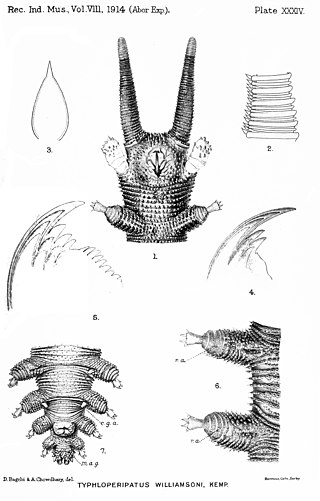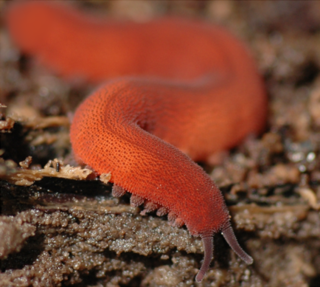
Onychophora, commonly known as velvet worms or more ambiguously as peripatus, is a phylum of elongate, soft-bodied, many-legged panarthropods. In appearance they have variously been compared to worms with legs, caterpillars, and slugs. They prey upon other invertebrates, which they catch by ejecting an adhesive slime. Approximately 200 species of velvet worms have been described, although the true number of species is likely greater. The two extant families of velvet worms are Peripatidae and Peripatopsidae. They show a peculiar distribution, with the peripatids being predominantly equatorial and tropical, while the peripatopsids are all found south of the equator. It is the only phylum within Animalia that is wholly endemic to terrestrial environments, at least among extant members. Velvet worms are generally considered close relatives of the Arthropoda and Tardigrada, with which they form the proposed taxon Panarthropoda. This makes them of palaeontological interest, as they can help reconstruct the ancestral arthropod. In modern zoology they are particularly renowned for their curious mating behaviours and the bearing of live young in some species.

Peripatus is a genus of velvet worms in the Peripatidae family. The name "peripatus" is also used to refer to the Onychophora as a whole, although this group comprises many other genera besides Peripatus. The genus Peripatus is found in Central America, the Caribbean and northern South America.
Macroperipatus is a genus of Neotropical velvet worms in the Peripatidae family.
Mesoperipatus is a monospecific genus of velvet worm in the Peripatidae family, containing a single species Mesoperipatus tholloni. It is found in Gabon, making it the only known species of velvet worm in the tropics of Africa, and the only known species of peripatid velvet worm in Africa. Females of this species have 24 to 27 pairs of legs; males have 23 or 24.

Typhloperipatus is a genus of velvet worm in the family Peripatidae, containing the sole species Typhloperipatus williamsoni. It is the only species in the phylum found in South Asia. The species was discovered in northeastern India in 1911.

Peripatidae is a family of velvet worms. The oldest putative representatives of the family herald from Burmese amber dated to the mid-Cretaceous, around 100 Ma, with representatives from Dominican and Baltic amber attesting to a broader distribution in the Palaeogene / Neogene; molecular variability suggests that the family's crown group may have arisen in the early Mesozoic.
Epiperipatus barbouri is a species of velvet worm in the Peripatidae family. Females of this species have 30 to 34 pairs of legs. The type locality is in Grenada.

Epiperipatus biolleyi is a species of velvet worm in the Peripatidae family. Females of this species have 29 to 31 pairs of legs; males have 25 to 28. Females range from 25 mm to 55 mm in length, whereas males range from 22 mm to 29 mm. The type locality is in Costa Rica.
Epiperipatus simoni is a species of velvet worm in the Peripatidae family. Females of this species range from 40 mm to 68 mm in length and have 28 to 32 pairs of legs. The type locality is in Venezuela.
Epiperipatus vagans is a species of velvet worm in the Peripatidae family. The male of this species has 29 or 30 pairs of legs; females have 32 or 33. The type locality is in Panama.

Epiperipatus edwardsii is a species of velvet worm in the Peripatidae family. Females of this species have 29 to 34 pairs of legs; males have 28 to 30. Females range from 23 mm to 56 mm in length, whereas males range from 25 mm to 30 mm. The type locality is in French Guiana.
Epiperipatus hilkae is a species of velvet worm in the Peripatidae family. Males of this species have 25 to 27 pairs of legs; females have 28 to 29. The type locality is in Costa Rica.
Macroperipatus valerioi is a species of velvet worm in the Peripatidae family. Females of this species have 34 pairs of legs. The type locality is in Costa Rica.

Tasmanipatus barretti, the giant velvet worm, is a species of velvet worm in the Peripatopsidae family. It is the sole species in the genus Tasmanipatus and is ovoviviparous.
Heteroperipatus clarki is a species of velvet worm in the Peripatidae family. Females of this species have 26 to 29 pairs of legs. The type locality is in Panama.

Peripatus juanensis is a species of velvet worm in the Peripatidae family discovered in Puerto Rico in 1900. As of 2018, it is the only velvet worm found in Puerto Rico. Females of this species have 31 or 32 pairs of legs; males have 27.
Peripatus ruber is a species of velvet worm in the Peripatidae family. This species has 30 pairs of legs. The type locality is in Costa Rica.
Mongeperipatus solorzanoi, or Solórzano's velvet worm, is a species of velvet worm in the Peripatidae family.
Mongeperipatus kekoldi is a species of velvet worm in the Peripatidae family. Males of this species have 32 or 33 pairs of legs; females have 37 to 39. The largest females can reach 18 cm in length. This species was discovered in Costa Rica.
Epiperipatus bernali is a species of velvet worm in the family Peripatidae. This species has 31 or 32 pairs of legs.







